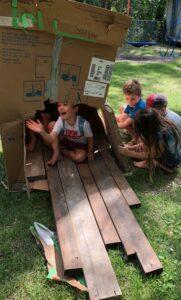“Schemas are “a repeated pattern of action and behaviour, seen in many different areas of play. They become ‘established foundations for learning’.” Cathy Nutbrown, 2006
The more we know and understand about Schema Theory, the easier it is to identify the various Schemas children engage in. Schemas can be found in children’s play of all ages and in all curriculum areas including science and construction.
When you first start looking for Schemas, some of the easier ones to identify are:
- Transporting: moving things or themselves from one area to another. (carrying, pushing)
- Trajectory: moving objects or themselves. (dropping, kicking, climbing, jumping, building and knocking down)
- Transforming: Exploring and seeing changes in materials like paint, water, clay, sand, etc. (mixing, observing changes like melting)
- Enclosing & Enveloping: children surrounding themselves or things. (sitting in boxes, hiding in blanket tents, wrapping toys with cloth or paper, drawing a border around their drawing)
- Connecting & Disconnecting: children connecting and disconnecting materials. (train tracks, lining up toys, threading beads, tying with rope, building with blocks)
There are many more.
To be able to recognize Schemas, the ECE needs to be able to slow down and really ‘see’ what the children are doing. This allows us to reflect on our observations and try to understand what is happening. Look for the action (verb) that they are engaged in (rather than the noun or what they are playing with). This helps identify the Schema the children might be exploring. Watch to see if they are repeating this action in the same way or in variations. We can often see children engaged in more than one Schema at a time.
Construction
As children use a variety of materials to construct with, you can see many Schemas emerging in their play. Construction materials may include blocks, sand, snow, styrofoam, cardboard, sticks, etc.
When building with blocks children are using transporting and connecting. Enclosing and enveloping are seen when they take the block structure and add a space to sit in, when they incorporate other toys (eg. animals, cars) or by placing a blanket over top as a roof.
When children create paths and waterways in the sand they are exploring trajectory; moving the water or other materials like balls through the paths. If they add a PVC pipe tunnel, they are working on enclosing the water and trajectory as it moves through the pipe and down the path from the top to the bottom.

Science
Transformation is one of the easiest Schemas to see in science. It’s the mixing of materials to create something else. It’s cooking muffins, making mud pies or looking through prisms to see things from a different perspective. Science is about figuring out how and why things work or react together. What colours can be created by mixing paint colours? What happens when the ice blocks are brought outside?
An example I love to share is about a child wanting to make his own Play-Doh. Since my job is to support and provide what he requires, I asked him what he needed. He required flour and water. I brought him bowls of both. Through his mixing, we had conversations about what happened when he had too much water or when he added too much flour. After a while, he got the mixture just right and created himself a little ball of dough. The child repeated this activity for several days. He made strong connections as he worked with the transformation of materials.
Mixing Science and Construction
After the children have created their paths in the sand they will often ask for baking soda and vinegar. One child pours baking soda down the path or into the PVC pipe. Another child pours in the vinegar and they watch that chemical reaction. They are so excited to see the baking soda and vinegar transformation and watch as it travels down the sand path and through the PVC pipe to the bottom. The children will recreate this over and over by making different paths and using different tubes and hoses. The children are not only combining science and construction but they’re exploring transporting, transforming, trajectory, connecting and disconnecting, enclosing, and positioning and ordering.
My challenge to you is to slow down and look for the action words; Are they moving materials around the room or yard, hiding under a blanket or in a box, or are they mixing things? Then in collaboration with other staff and the children, find ways to support this exploration. Schemas can be found everywhere, we just need to look for them.
References
Curtis, D., & Jaboneta, N. (2019). Children’s lively minds: Schema theory made visible. Redleaf Press.
Grimmer, T. (2017). Observing and developing schematic behaviour in young children: A professional’s guide for Supporting Children’s learning, play and development. Jessica Kingsley Publishers.
As it appeared in the Summer 2022 MCCA Bridges magazine

